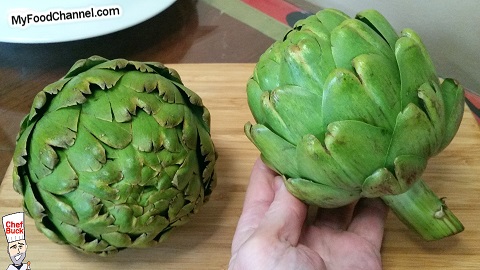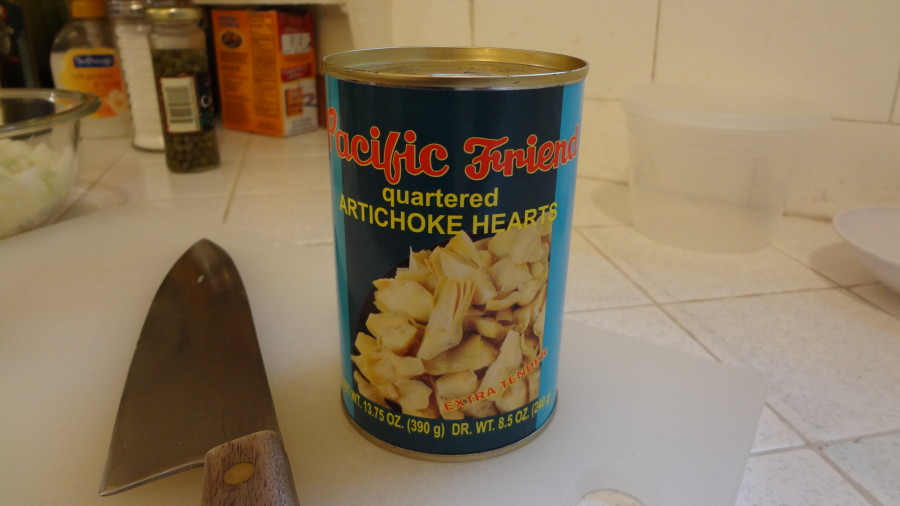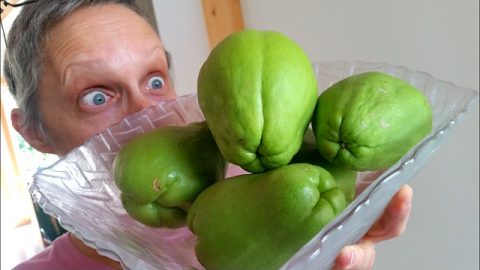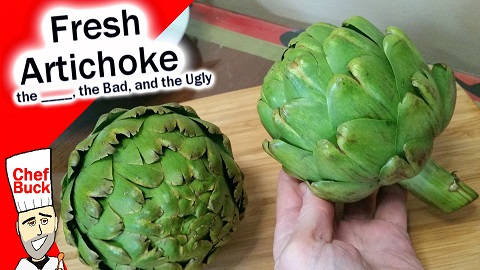If you’re curious about fresh artichoke, Buck and I will provide two different perspectives on this vegetable. We’ll walk you through the pros and cons of cooking a fresh artichoke, how to pick a good one, tips to prepare and microwave-steam an artichoke, and some dip/sauce ideas to compliment your cooked, warm veggie.
Fresh artichoke is one of those foods I toss into the same category as crab legs and crayfish; fancy and delicious foods, and usually a bit expensive. And with each of these foods, you have to work hard for your bites and there are few edible parts compared to the discarded/inedible parts. And if you haven’t watched the video, spoiler alert, Buck has very little use for a fresh artichoke. 😉
Why Eat Fresh Artichoke?
So why eat fresh artichokes when there are other delicious foods that don’t require so much work?
Variety is the spice of life. Our bodies appreciate getting nutrition from a variety of natural sources. Artichokes are packed with potassium, vitamin C, vitamin K, folate, magnesium and dietary fiber. And according to Webmd.com, artichokes are number 7 on the USDA’s top 20 antioxidant-rich foods list.
Maybe you want to impress someone who’s favorite food is fresh artichoke. Maybe preparing and eating fresh artichoke can be an effective part of your mindfulness practice.
Plus, despite what Buck thinks, every mouthful of food does not have to be a big one to be satisfying.
Tips To Pick The Best Artichoke.
Just to be clear, we are talking about globe artichokes in this article. If you are unfamiliar with artichokes and see a reference to a Jerusalem or Chinese artichoke, just know that those are very different vegetables.
Ever see a globe artichoke growing? It looks like what it is – the flower on a tall thistle plant. Keep that in mind when you’re trying to remember how to pick the freshest artichokes. You want THiStleS.…..
- Tight. The leaves are still pretty tight or close together, they haven’t opened up too much.
- Heavy. A lighter artichoke can indicate a more dried out veggie.
- Squeaky. If you gently squeeze a fresh artichoke, it will ‘squeak’ slightly.
- Stemmy. It’s a nice bonus when you have 1-2 inches of stem. The stem’s interior is almost as yummy as the artichoke heart.

Want To Avoid A Long Cooking Process?
As with many foods, you can prepare artichokes in a variety of ways. What’s the quickest, and one of the most nutritious ways to prepare fresh artichokes? Well, let’s compare some cooking times.
Stuff and Bake. You can add some great flavors but expect an hour of cooking time.
Grill. Great grill taste but you need 45 minutes of cooking time.
Boil or Steam on the Stove. After the water comes to a boil, it takes another 20-35 minutes, depending on artichoke’s size
Use a Pressure Cooker. Cooks faster, but you need a pressure cooker. And, it’s harder to tell when the artichokes are done.
Microwave Steaming. Generally will take about 6-10 minutes to microwave steam an entire artichoke, depending on your microwave’s power settings, and the size of the artichoke. DING, DING, DING – WE HAVE A WINNER!
Tips For The Best Steamed Artichokes In The Microwave.
So, you’ve decided to steam an artichoke in the microwave. Here’s how to make the most of it.
Prep The Artichoke.
Before microwaving, cut the top third of each artichoke off. This is going to be the toughest, inedible artichoke leaves so don’t be sad. You can always make your compost pile a little happier with inedible artichoke parts. A sharp, serrated knife helps cut through the top. Even better, use an electric knife, if you got it.
To keep it from browning before you eat it, once you cut it, sprinkle with some lemon or lime. Some types of fresh artichokes brown more easily than other. One good thing – if it does brown, it doesn’t impact the taste.
Find The Right Dish.
You want a dish where you can place the artichoke(s) cut side down, with about ¼ – ½ cup of water in the bottom, and that can be tightly covered. The cover can be the microwavable lid, a dinner plate, or plastic wrap.
Add Some Seasoning Before You Cook.
Add a bay leaf and/or some lemon to the water. Sprinkle some herbs over the artichokes before you cook it.
To increase the cooking time even more, cut your artichoke into 4-6 parts. This way, you have more surface area to season, and you will reduce your cooking time even more.
Avoid Overcooking Your Artichoke.
Although the microwave makes cooking the artichokes fast and easy, you don’t want to overcook your artichoke. And different sized artichokes will cook differently. Check a whole artichoke after 7 minutes to get an idea how fast your microwave is cooking. If you cut your artichoke in halves or quarters, check it after 4 minutes. You know the artichoke is done when you can pull an outer leaf off with ease.
Serve Warm.
Let the artichoke cool slightly, but serve warm.
Serve With One or Two Dipping Sauces.
There are endless possibilities for dipping sauces. You can buy or make something ahead of time. Some favorite homemade choices that complement the artichoke’s taste include:
- Sauteed garlic and melted butter. Saute 2 Tbsp of minced garlic in 1 Tbsp of butter, then melt 4 Tbsp more of butter.
- Mayo with balsamic vinegar. Mix together 3 Tbsp mayo with 2 tsp of balsamic vinegar. Alternatives: Yogurt for the mayo; soy sauce or tamari for the balsamic vinegar.
- Pesto. You don’t have to use fancy pants and expensive pine nuts either. You can substitute walnuts or almonds. Check out our Pesto Recipe.
Buck ONLY buys canned or jarred artichoke…because he thinks you’d be crazy not to. This is one of the best prices I found on Amazon for Canned Artichokes but mostly the artichoke prices are pretty over the top online…so definitely check your local grocery store first for canned or jarred artichoke.

What’s Edible on an Artichoke …and what’s not
Remember I said there is plenty of the artichoke that is not edible? The video shows you what you can eat. Here’s a summary of what is edible and not. Artichoke Trivia: The fuzzy hairs found at the center of the veggie, on top of the artichoke heart, are called the ‘choke’.
Not Edible:
- The outer layer(s) of leaves. Each artichoke is different – sometimes you have to pull away 2-3 layers of leaves before you find one whose base is tender enough to scrape out with your teeth.
- Leaf ends. In fact, there is just a small part at the base of each internal leaf that is edible.
- End of central flower. These are the thinner leaves found in the center of the artichoke, that are touch. Depending on the variety of globe artichoke you have, the flower may be white or purple.
- Fuzzy hairs found on the top of the artichoke heart. One exception: In baby artichokes, the fuzzy hairs are edible because they aren’t formed enough to be a distraction.
- Stem’s exterior.
Edible:
- White/lighter colored base of each inner leaf. So how do you eat it? You pull a leaf off, dunk it in your favorite dipping sauce, then use your teeth to squeeze out the interior. The closer you get to the center, the tender/edible part of the leave gets bigger. Um, well, relatively speaking. Don’t ever expect a big mouthful of taste from the artichoke leaves. It’s one of the reason Buck grumbles so much about fresh artichokes.
- Base of the inner leaves (purple or white flower). Similar to the individual leaves, the base of the artichoke’s central purple flowers are edible. Just pull off the whole cluster of central, thin flower petals and use your teeth to tear off the tender base.
- Artichoke heart. Don’t forget to pull out/spoon out the fuzzy top first. You also can use a spoon to scoop out the heart. Now you can buy jars of plain or marinated artichoke hearts; can you believe there was a time when folks threw that away? Guess the fuzzy part threw them off?
- Stem’s interior. If you look at the stem from the end, you will see that about ⅔ of the stem are darker and more fibrous. You want to cut out the inner, lighter part of the stem. Again, the amount of edible stem depending on the type of artichoke you have, and its age.
For another interesting vegetable, here’s all you need to know about Chayote.

Thanks for checking out our Fresh Artichoke video, and all of our recipes. Be sure and sign up for our mailing list and never miss a new Chef Buck cooking video, and also click a button below and share the dishes with your friends. We appreciate all the kind comments and support, and we’ll see you next time in the kitchen!
–Chef Buck
We appreciate you watching our videos…Thanks!
We include affiliate links for products on our website, so if you make a purchase after clicking on our links, we may earn a commission which helps us produce more videos and drink more coffee :^) We are participants in the Amazon Services LLC Associates Program, which is an affiliate advertising program that provides a means for us to earn fees by linking to Amazon.com and affiliated sites, so we can make more videos.
